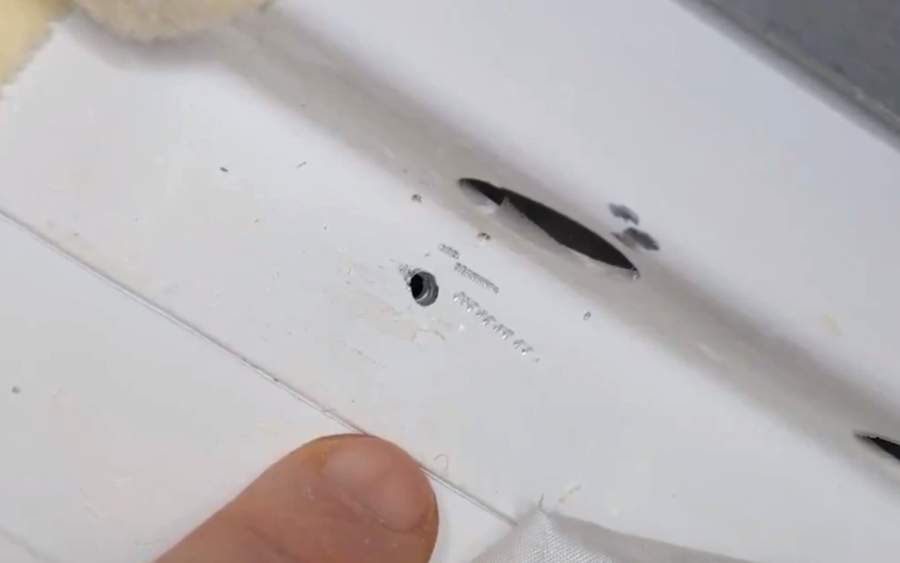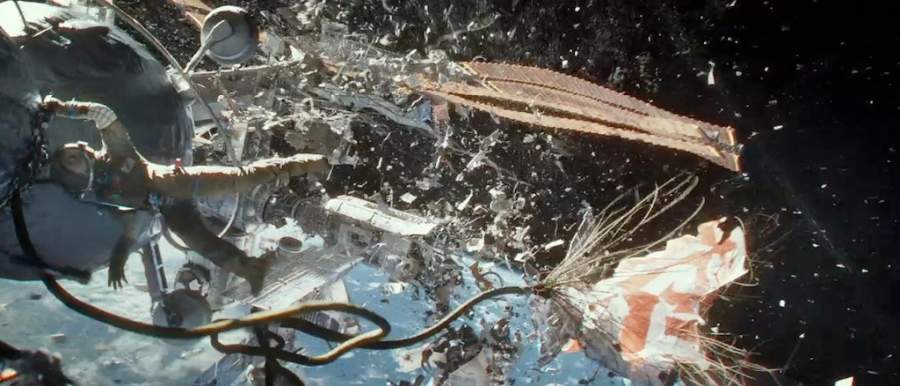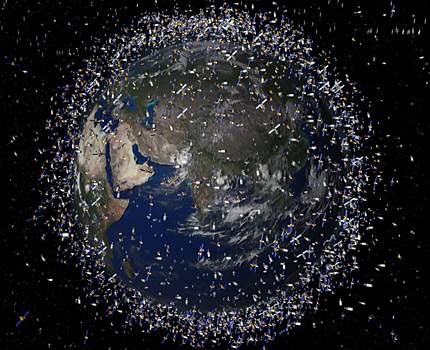The problem with the space station (it was leaking air) has been identified. From there, the story gets bizzare. [guard]
Was it sabotage or sloppiness? Someone drilled a hole in the aluminum hull of the habitat. Then, they patched it up with some glue. You can see the scratches where the drill-bit “walked” before it bit (well, you wouldn’t expect a space habitat saboteur to center-punch a neat machinist’s hole!)

That’s a little bitty hole. It’s also not anywhere where a hole should be – this was not a misplaced rivet hole that someone tried to cover up. It appears to be in a spot where the aluminum is overlapped, where it’s less likely to split or tear.
It’s probably the CIA.
Just kidding. Fake news. But you can be sure that there are some pointed questions being asked right about now. This feels like something out of a bad Tom Clancy novel; one written as an excuse to loft Clancy’s ‘Mary Sue’ character Jack Ryan into space so he can save the day for the USA!
Just sit an enjoy a brief boggle over this one; cui bono?

Gravity, the movie. Americans littering again.
Somewhat related is an interesting topic: what happens when there is a nasty disaster in orbit? Remember Gravity (2003) starring a bunch of special effects and Sandra Bullock and George Clooney? That sort of thing would leave a monstrous huge debris footprint that might trigger a sort of chain-reaction in which everything in orbit begins to disintegrate as it’s hit with little chunks of everything else in orbit. That scenario is called the Kessler Syndrome – space junk gone wild. [wik] Alternate spine-chilling term: ablation cascade.

What if each piece of space junk split into more space junk?
NASA is on the problem, naturally. So, basically it’s a matter of tracking the existing gigantic amount of debris. [nasa] Because, as usual, humans have been crapping all over everything. I’m going to sit back comfortably and assume NASA’s got it under control and global warming is going to wipe us out before it matters.

 Couldn’t we just buy one fewer F-35 and fully fund NASA for a couple years?
Couldn’t we just buy one fewer F-35 and fully fund NASA for a couple years?
The macguffin in Neal Stephenson’s Seveneves is a sort of Kessler Syndrome.

I’ll out myself first by confessing that I liked Red October (the movie) and if they did come up with a sequel in space I’d give it a go.
Embarrassing asides aside, I’m in the “unadmitted screw up”-camp right now. If it was deliberate sabotage to derail the crewed space programme, or ISS or Soyuz specifically, that hole probably wouldn’t have been put in a section of the craft that doesn’t affect reentry. Even a saboteur with scruples (that is, not trying to kill the returing crew) would probably have aimed to inflict damage in a noticeable way that still prevents the Soyuz from returning. If you have to replace your return vehicle (and escape pod) that should raise enough questions and doubts about the already high-risk venture that is the ISS.
A homesick cosmo-/astronaut could have found a better way to force a return, too. Long before things got so bad for them that they’d contemplate drilling holes in spaceships they’d probably just ask to be sent home. They’d might never fly again but wouldn’t mind either. It wouldn’t surprise me if that’s a contingency they train for these days. In fact it would suprise me if they didn’t.
Lastly, lack of skilled workers, money and more has been a mantra that’s been following the Russian space industry for years. Usually everyone gets the reminder whenever a rocket blows up but it was just a matter of time before something crewed would be affected, too.
Cui bono?
Good question, if it applies. Unless you have a petty nationalist agenda dictate your actions or you simply hate the idea of people being sent into orbit… noone?
Trying to sabotage either the ISS or Soyuz doesn’t get you much business-wise since there are no alternatives. Maybe if you had your own ready-to-go space capsule to sell seats on you might like to see Soyuz and it’s track record go down the drain but there aren’t any alternatives – yet. The Chinese are happily doing there own thing and barring the nationalist thing and some sour grapes over being excluded from the ISS they gain nothing.
Russia probably wouldn’t be poking holes in one of its national trademarks – not deliberately, anyway. North Korean hackers seem unlikely culprits for actual hole-drilling. And the Americans do have astronauts up there who depend on Soyuz as much as anybody else. (That doesn’t explicitly rule out the CIA, perhaps)
So I’d bet on an unlucky engineer or technician who thought they’d get away with it, no trouble to anyone. If they had it wouldn’t have been the first impromptu patch-job over the decades. And I freely confess, at the prospect of telling my supervisor I just broke the expensive spaceship I’d find myself a tad weak-kneed, too. I’d like to think I’d come forward, but I’m not entirely sure I actually could.
I need my job, I like my job, and while I take it very seriously, I might just convince myself that I can fix this without having to bother anyone with … minor issues. (In this scenario I’m a skilled engineer who builds spaceships all day long, after all)
P.S.: There are some nuclear-powered satellites up there, too. So when the cascade finally occurs, on top of everything else we might end up with a faint sprinkling of radioactive debris. That’ll be extra-fun to deal with, especially for crewed spacecraft. If one of those is hit and survives you still have to figure out if it was contaminated and how to decontaminate it.
As Komarov said I too would guess an underpaid worker with unspecific work orders did drill the hole by accident.
Scott Manley discussed it as well and Roskosmos seems to be checking all their capsules. So probably incompetence. I hope.
Having worked at a manufacturing plant where we built one-off designs, there are usually fewer mistakes on mass production work because you get a rhythm going with familiar parts being made over and over again, it looks like someone was told to drill a starter hole and left specifying the face where it was to go vague. Then, faced with an extra hole they failed to repair it immediately or formally note the need to fix it. Typically you figure ‘sure … we’ll send in Ned with his welder in the assembly shop … no problem … a buzz and a spot of paint and we’re good’ and then everyone forgets about it, or seeing it, figures it is supposed t be that way. Sure ‘that’s where one of them vibro-thermo-dealies goes’.
If this sounds like a poorly run body shop repairing AMC Pacers with junkyard parts you have the picture. I’ve talked someone about the Putin-era Russian space program. In their prime the Russian programs were always looser and rougher than the US system at its prime. Some of this is attitude. The Russians were always rough and ready compared to the priggish and pedantic US programs. Of course the US programs got sloppier when their budgets were no longer so generous. And both programs were capable of mistakes. But after the collapse of the USSR budgets were nonexistent for year, many experts wandered off, the culture of safety and accountability, and the rigid systems of procedures and inspections, disintegrated.
Clearly, the guy working the drill was not a formally trained and procedures-bound machinist who knows his every move will be judged. I don’t see layout lines, a prick punched start, followed by a center punch to keep the bit from walking. It looks to me, based upon the marks beside the larger hole, like the mechanic ran the drill chuck into flange on the side when he broke through. Sloppy. All those faults are forgivable if your drilling a hole to bolt up a bracket for the muffler on your tractor. On a spacecraft, even one destine to burn up, it is worrying.
Then again: ‘I felt exactly how you would feel if you were getting ready to launch and knew you were sitting on top of 2 million parts — all built by the lowest bidder on a government contract.’
Attributed to John Glenn
There’s a thing management does, even in the best of space programs, where they tell you to be sure to report any issues as soon as they arrive, while at the same time training you to never report any issues until you’re 100% certain you can’t fix them yourself. They do this by taking any issue as a sign of needing more oversight, and since the only tool in their drawer is reading reports, that means more reports!! Behind schedule because your project is short-staffed? We’ll fix it by demanding another 80 person-hours per week to support a weekly meeting on why you’re behind schedule.
I can easily imagine a work environment where everyone knows that fessing up would mean the loss of your job. Congratulations, management! You’ve just guaranteed something like this will happen eventually.
I am in the mistake camp too.
You would think that putting a hole where none should be would be an unlikely mistake, but on the list of embarrassing mistakes in space programs this does not even rank very high.
Remember the Proton rocket that went down because acceleration sensors was built in the wrong way around (http://www.russianspaceweb.com/proton_glonass49.html)? That sensor was not only mark very clearly, it was shaped in a way that it could only be placed in the correct way without not certified tools and procedures. A technician still got it in the wrong way. Three times.
Compared to that, drilling an extra hole and thinking: “I could get yelled at or use some glue” seems outright sensible. It would even have worked if that capsule would not have ended up as emergency capsule on the ISS, it took months for that glue to fail.
Turi1337@#6:
Compared to that, drilling an extra hole and thinking: “I could get yelled at or use some glue” seems outright sensible.
I think that, if it was an accident, the driller should have realized “I am going to get yelled at no matter what.”
Remember the Proton rocket that went down because acceleration sensors was built in the wrong way around (http://www.russianspaceweb.com/proton_glonass49.html)? That sensor was not only mark very clearly, it was shaped in a way that it could only be placed in the correct way without not certified tools and procedures. A technician still got it in the wrong way. Three times.
We had a guy in our reserve unit who turned in an M-16 with the bolt-carrier installed backwards. Any of you who are familiar with the design are probably thinking “that is not even possible” – and that’s what I thought, too. It looked like it had been hammered with a hammer. There was a lot of boggling that day. (The paper-work to tell the US Army “this automatic rifle is no longer a rifle” is really complicated. It takes a lot of convincing.)
@7
“I think that, if it was an accident, the driller should have realized “I am going to get yelled at no matter what.””
Not necessarily. The fact that the hole was up there for two months before it was discovered shows that the hole was plugged in some kind, most likely with glue. If this part had been used for any other kind of mission than an ISS emergency pod mission, nobody would have ever known that the hole even existed*. Add to that the probability of the technician not knowing that this glue would fail after a few months in contact with the vacuum of space and I would say that this is a considerable more likely explanation.
*OK, actually this hole should have been found in the QA process anyways. But neither where the wrongly installed sensors, which shows a very damning light on the Russian QA process.